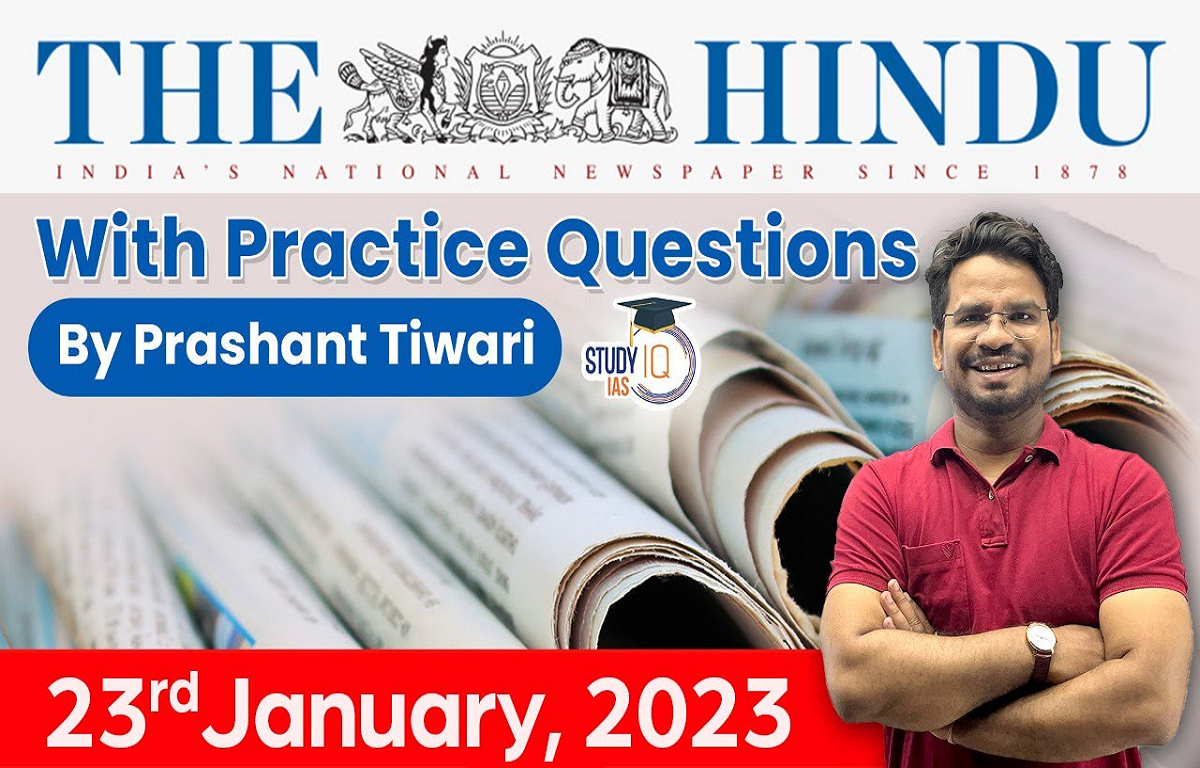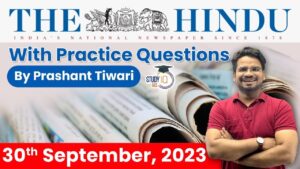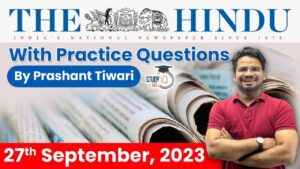The Hindu Newspaper Analysis for UPSC

The Hindu Newspaper Analysis 21 January 2023
- In a sign of escalating tensions, Union Law Minister Kiren Rijiju on Sunday said the majority of people had “sane views”, similar to the one expressed by a retired High Court judge, who said the Supreme Court had “hijacked” the Constitution by deciding to appoint judges by itself.
- Rijiju took to Twitter to share a video interview of the former Delhi High Court judge, Justice R.S. Sodhi (retd), who said, “…Only Parliament will amend the Constitution. But here, I feel the Supreme Court for the first time hijacked the Constitution. After hijacking, they [the SC] said that ‘we will appoint [judges] ourselves and the government will have no role in it’.”
The Hindu Editorial Today

- The Supreme Court collegium has done well to push back against the Union government’s attempts to block the appointment of some advocates as High Court judges.
- The three-member collegium, which makes recommendations for High Court appointments, has reiterated its decision to elevate lawyers Saurabh Kirpal to the Delhi High Court, R. John Sathyan to the Madras High Court and Somasekhar Sundaresan to the Bombay High Court.
- The government appears to think that potential candidates for judicial appointments should not have political views of their own, or that a tendency to make their views or opinion known will amount to a possible bias in their functioning as judges.
- Nothing can disprove this more than the fact that there are other names — to which the government seems to have no objections — that are closely associated with political parties.
- Articles 124(2) and 217 of the Indian Constitution deal with the appointment of judges to the Supreme Court and High Courts .
About:
- It is the system of appointment and transfer of judges that has evolved through judgments of the SC, and not by an Act of Parliament or by a provision of the Constitution.
First Judges Case (1981):
- It declared that the “primacy” of the CJI’s (Chief Justice of India) recommendation on judicial appointments and transfers can be refused for “cogent reasons.”
- The ruling gave the Executive primacy over the Judiciary in judicial appointments for the next 12 years.
Second Judges Case (1993):
- SC introduced the Collegium system, holding that “consultation” really meant “concurrence”.
- It added that it was not the CJI’s individual opinion, but an institutional opinion formed in consultation with the two senior-most judges in the SC.
Third Judges Case (1998):
- SC on the President’s reference (Article 143) expanded the Collegium to a five-member body, comprising the CJI and four of his senior-most colleagues.

- The Governors are once again becoming public spectacles in many States, as seen in Punjab, Maharashtra, Kerala, Tamil Nadu, Telangana, West Bengal, Jharkhand, Delhi, and in a few others earlier. Three issues stand out in their grandstanding with the elected governments in the States in question.
- To be in tune with these demands, Governors should not merely have their ear to the ground but also be attuned to the embedded idea of the common good manifest in its institutions and public culture. In a country such as India it is not difficult to find such persons.
- He/she is the Chief Executive Head of a State.
- Like the President of India, he is a nominal (titular or constitutional) head and also acts as an agent of the central government. Therefore, the office of governor has a dual role.
- Articles 153 to 167 in Part VI of the Constitution deal with the State Executive, which comprises the Governor, the Chief Minister, the Council of Ministers and the Advocate General of the State.
- There is no office of Vice-Governor (in the state) like that of Vice-President at the Centre.
- Usually, there is a governor for each state, however, the 7th Constitutional Amendment Act, 1956 facilitated the appointment of the same person as a governor for two or more states.
Appointment
- The Governor is neither directly elected by the people nor indirectly elected by a specially constituted electoral college as is the case with the President.
- He/she is appointed by the President by warrant under his hand and seal.
- As held by the Supreme Court in 1979, it is an independent constitutional office and is not under the control of or subordinate to the Central government.
- While drafting the Constitution, the Canadian model of Governor’ appointment by the Centre was accepted in the Constituent Assembly.
Qualifications
- The Constitution lays down only two qualifications for the appointment of a person as a governor.
- He/she should be a citizen of India.
- He/she should have completed the age of 35 years.
Additionally, two conventions have also developed in this regard over the years.
- He/she should be an outsider, meaning not belonging to the State of appointment so as to remain free from the local politics.
- While appointing the Governor, the President is required to consult the Chief Minister of the State concerned, so that the smooth functioning of the constitutional machinery is ensured.

- A report by the World Bank, released in November last year, on financing India’s urban infrastructure needs, focuses on private investments ameliorating urban problems.
- The push to attract private capital, since the 1990s, followed by the urban reforms under the United Progressive Alliance I regime, the Smart City mission, and now this report, continues to plague India’s policy paradigm in the urban sector.
- After three decades of reforms, urban finance predominantly comes from the government. Of the finances needed to fund urban capital expenditures, 48%, 24% and 15% are derived from the central, State, and city governments, respectively. Public–private partnership projects contribute 3% and commercial debt 2%.
- The World Bank estimates that nearly $840 billion (₹70 lakh crore) would be needed for investment in urban India to meet the growing demands of the population, and $55 billion would be required annually.
- The basic problem with this report and other reports drawn up in a similar fashion is that they are made using a top to bottom approach, with too much of a focus on technocentric solutions using very high capital-intensive technologies.
- For the urban context, plans must be made from below by engaging with the people and identifying their needs.
- Empowering the city governments and the people at large is the second point.

- India’s financial sector is highly exposed to the risks of the economy transitioning from being largely dependent on fossil fuel to clean energy
- In 2021, Prime Minister Narendra Modi committed India to reach net-zero emissions by 2070. India has also announced plans to source half of its electricity needs from non-fossil fuel sources by 2030. However, the country has also maintained that it needs financing to the order of at least a trillion dollars to meet these commitments.
- Green bonds are issued by companies, countries and multilateral organisations to exclusively fund projects that have positive environmental or climate benefits and provide investors with fixed income payments.
- The projects can include renewable energy, clean transportation and green buildings, among others.
- Proceeds from these bonds are earmarked for green projects. This is unlike standard bonds, the proceeds of which can be utilized for various purposes at the discretion of the issuer.


 The Hindu Newspaper Analysis 6 October 2...
The Hindu Newspaper Analysis 6 October 2...
 The Hindu Newspaper Analysis 30 Septembe...
The Hindu Newspaper Analysis 30 Septembe...
 The Hindu Newspaper Analysis 27 Septembe...
The Hindu Newspaper Analysis 27 Septembe...





















